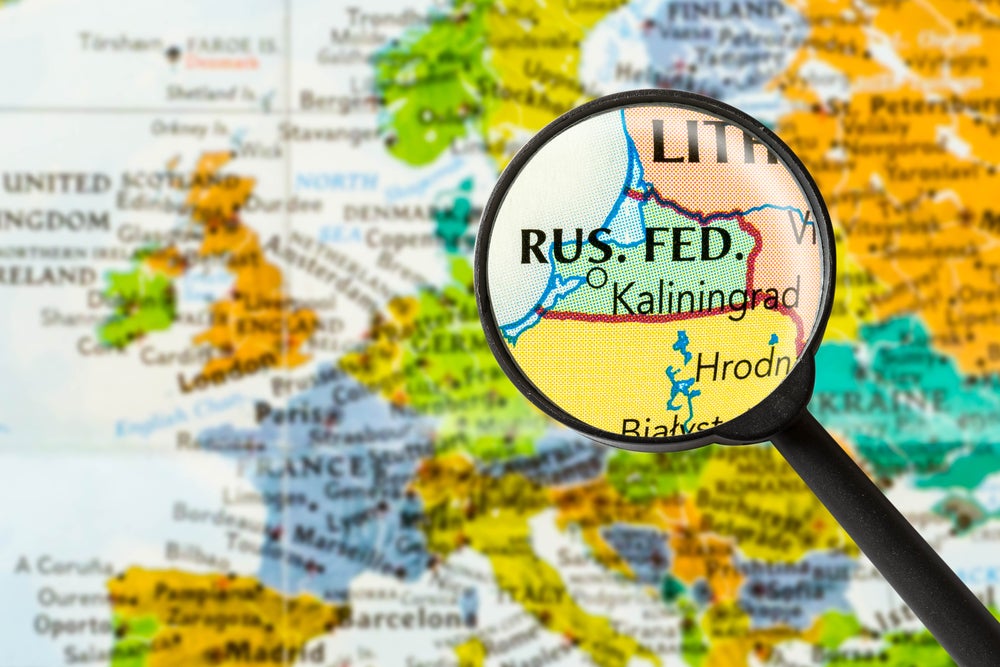
Stretched along the Baltic Sea, sandwiched between Poland and Lithuania, lies the Russian territory of Kaliningrad. The region, or ‘oblast’ as it is known in Russia, is a little smaller than Belgium, geographically speaking, and is home to some 800,000 residents, half of which live in Kaliningrad’s main city, which is creatively named Kaliningrad.
Being an enclave, the region shares no borders with mainland Russia, floating somewhat awkwardly within the EU. There is now a real chance of this awkwardness becoming dangerous. Since the invasion of Ukraine tensions around Kaliningrad have mounted significantly.
In mid-June, for example, Lithuania took the unprecedented decision to block certain goods from entering Kaliningrad from Russia by rail, in line with EU sanctions. Russia’s foreign ministry called the move “illegal” and has threatened “to take actions to protect its national interests”. The oblast relies on free transit through Lithuania in order to transfer goods to and from Russia.
A very brief history of Kaliningrad
Kaliningrad has a long history as a geopolitical flashpoint. Founded by Teutonic knights in the 13th century, and known then as Koenigsberg, several centuries later it became the capital of the German state of Prussia.
The region remained part of Germany until its annexation by the USSR after the Second World War, during which time it suffered widespread destruction. After the war, the German population was expelled.
During the Soviet period, the territory was a closed military zone, one of the most militarised parts of the USSR, in fact. So important was Kaliningrad's military industrial complex that, when the Soviet Union fell, the region’s economy fell with it.
Kaliningrad remains a military bastion for Russia
The years and decades since the Cold War have seen the remilitarisation of Kaliningrad, not least due to its unusual location nestled within the EU. As such, Kaliningrad is of great strategic importance to Moscow.
Today, it houses the Russian Baltic Fleet at the port of Baltiysk, making it Russia’s only ice-free European port, as well as a number of well-equipped tank, infantry and artillery divisions. Over the past decade, Russia has deployed to the region short-range Iskander ballistic missiles capable of carrying nuclear warheads – in response to Nato and the US deployment of a ballistic missile defence system in Europe.
In the months before the Ukraine invasion, Russia added even more firepower to Kaliningrad, once again citing alleged Nato aggression. Meanwhile, Nato denounced the move as another example of aggressive military posturing from the Kremlin.
An economic crisis is brewing in Kaliningrad
During the Soviet period, agriculture was as important to Kaliningrad’s economy as the military. After the fall of the USSR, Kaliningrad's production base was largely dismantled, causing the economy to nosedive in the early 1990s.
As a result, unemployment, poverty and social unrest soared. In 1996, the Russian authorities decided to turn the oblast into a special economic zone, meaning tax incentives and other advantages could be aimed at would-be investors. The move was very successful, leading to a decade-long boom and blossoming trade with its EU neighbours.
However, the 2008 global financial crisis hit Kaliningrad very hard, leaving unemployment at more than 10% – considerably higher than the Russian average. Western sanctions on Russia in the wake of 2014 Russian annexation of Crimea pushed the region’s economy down even further.
The sanctions led to the dismantling of Kaliningrad’s special economic zone privileges, which had allowed duty-free trade with EU neighbours, bringing the economy even closer to its nadir. The special economic zone had brought in 785 companies that employed almost 25% of the local workforce.
In the wake of the Ukraine invasion, the region has well and truly hit rock bottom, economically speaking. Surrounded by EU members, its isolation is particularly stark. The coming months are likely to ignite a series of geopolitical rows, all of which have the potential to explode out of control.



